Identification of hot spots in the variola virus complement inhibitor (SPICE) for human complement regulation
- PMID: 18216095
- PMCID: PMC2268448
- DOI: 10.1128/JVI.01935-07
Identification of hot spots in the variola virus complement inhibitor (SPICE) for human complement regulation
Abstract
Variola virus, the causative agent of smallpox, encodes a soluble complement regulator named SPICE. Previously, SPICE has been shown to be much more potent in inactivating human complement than the vaccinia virus complement control protein (VCP), although they differ only in 11 amino acid residues. In the present study, we have expressed SPICE, VCP, and mutants of VCP by substituting each or more of the 11 non-variant VCP residues with the corresponding residue of SPICE to identify hot spots that impart functional advantage to SPICE over VCP. Our data indicate that (i) SPICE is approximately 90-fold more potent than VCP in inactivating human C3b, and the residues Y98, Y103, K108 and K120 are predominantly responsible for its enhanced activity; (ii) SPICE is 5.4-fold more potent in inactivating human C4b, and residues Y98, Y103, K108, K120 and L193 mainly dictate this increase; (iii) the classical pathway decay-accelerating activity of activity is only twofold higher than that of VCP, and the 11 mutations in SPICE do not significantly affect this activity; (iv) SPICE possesses significantly greater binding ability to human C3b compared to VCP, although its binding to human C4b is lower than that of VCP; (v) residue N144 is largely responsible for the increased binding of SPICE to human C3b; and (vi) the human specificity of SPICE is dictated primarily by residues Y98, Y103, K108, and K120 since these are enough to formulate VCP as potent as SPICE. Together, these results suggest that principally 4 of the 11 residues that differ between SPICE and VCP partake in its enhanced function against human complement.
Figures

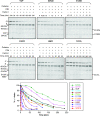
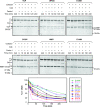

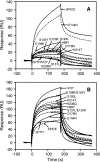

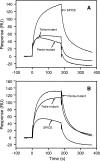
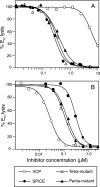
Similar articles
-
Species Specificity of Vaccinia Virus Complement Control Protein for the Bovine Classical Pathway Is Governed Primarily by Direct Interaction of Its Acidic Residues with Factor I.J Virol. 2017 Sep 12;91(19):e00668-17. doi: 10.1128/JVI.00668-17. Print 2017 Oct 1. J Virol. 2017. PMID: 28724763 Free PMC article.
-
Structure and regulatory profile of the monkeypox inhibitor of complement: comparison to homologs in vaccinia and variola and evidence for dimer formation.J Immunol. 2006 Mar 15;176(6):3725-34. doi: 10.4049/jimmunol.176.6.3725. J Immunol. 2006. PMID: 16517741
-
Variola virus immune evasion design: expression of a highly efficient inhibitor of human complement.Proc Natl Acad Sci U S A. 2002 Jun 25;99(13):8808-13. doi: 10.1073/pnas.112220499. Epub 2002 May 28. Proc Natl Acad Sci U S A. 2002. PMID: 12034872 Free PMC article.
-
Variola virus immune evasion proteins.Microbes Infect. 2003 Sep;5(11):1049-56. doi: 10.1016/s1286-4579(03)00194-1. Microbes Infect. 2003. PMID: 12941397 Review.
-
Structure-function relationships of complement receptor type 1.Immunol Rev. 2001 Apr;180:112-22. doi: 10.1034/j.1600-065x.2001.1800110.x. Immunol Rev. 2001. PMID: 11414353 Review.
Cited by
-
Regulators of complement activity mediate inhibitory mechanisms through a common C3b-binding mode.EMBO J. 2016 May 17;35(10):1133-49. doi: 10.15252/embj.201593673. Epub 2016 Mar 24. EMBO J. 2016. PMID: 27013439 Free PMC article.
-
Virus-Encoded Complement Regulators: Current Status.Viruses. 2021 Jan 29;13(2):208. doi: 10.3390/v13020208. Viruses. 2021. PMID: 33573085 Free PMC article. Review.
-
Spatially conserved motifs in complement control protein domains determine functionality in regulators of complement activation-family proteins.Commun Biol. 2019 Aug 5;2:290. doi: 10.1038/s42003-019-0529-9. eCollection 2019. Commun Biol. 2019. PMID: 31396570 Free PMC article.
-
Monkeypox virus and insights into its immunomodulatory proteins.Immunol Rev. 2008 Oct;225:96-113. doi: 10.1111/j.1600-065X.2008.00691.x. Immunol Rev. 2008. PMID: 18837778 Free PMC article. Review.
-
The origin of the variola virus.Viruses. 2015 Mar 10;7(3):1100-12. doi: 10.3390/v7031100. Viruses. 2015. PMID: 25763864 Free PMC article. Review.
References
-
- Adams, E. M., M. C. Brown, M. Nunge, M. Krych, and J. P. Atkinson. 1991. Contribution of the repeating domains of membrane cofactor protein (CD46) of the complement system to ligand binding and cofactor activity. J. Immunol. 1473005-3011. - PubMed
-
- Anonymous. 1980. Declaration of global eradication of smallpox. Wkly. Epidemiol. Rec. 55145-152.
Publication types
MeSH terms
Substances
LinkOut - more resources
Full Text Sources
Miscellaneous

